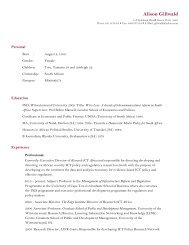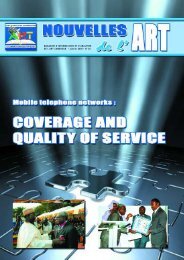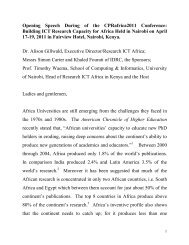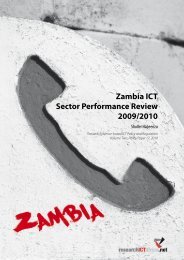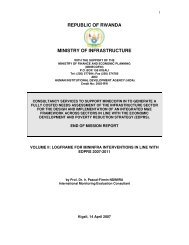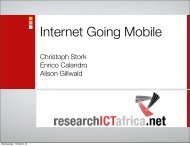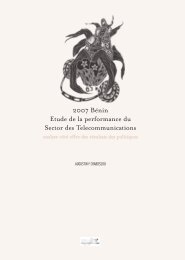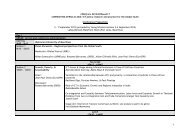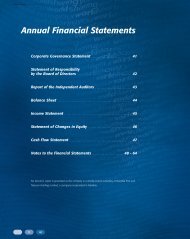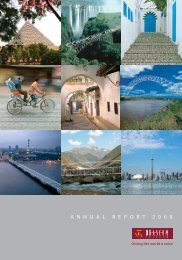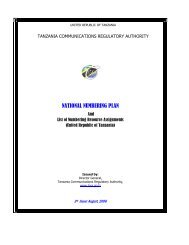Rwanda Telecommunications Sector Performance Review 2007
Rwanda Telecommunications Sector Performance Review 2007
Rwanda Telecommunications Sector Performance Review 2007
Create successful ePaper yourself
Turn your PDF publications into a flip-book with our unique Google optimized e-Paper software.
<strong>Rwanda</strong><br />
and potential return requirements are critical issues. The option of leasing<br />
circuits from any backbone provider is considered feasible. Similar<br />
arrangements exist already with microwave circuits leased from Terracom<br />
and MTN <strong>Rwanda</strong>cell. The company is heavily invested in satellite<br />
connectivity and is planning to acquire around 100 MBps bandwidth to<br />
serve their ISPs as well as government and non-government institutions.<br />
The company will also invest in terrestrial network backbone in order to<br />
reach out its customers. The key issue is the regulatory changes that are<br />
needed to introduce horizontal licensing in order to facilitate the emergence<br />
of wholesale and retail markets.<br />
Conclusion and<br />
Recommendations<br />
The overall performance of the sector can be characterised by two major<br />
aspects. Significant progress has been made both in policy and regulatory<br />
reforms that locate ICT as an engine for poverty eradication as a<br />
whole and a catalyst for socio-economic development across the various<br />
sectors of the economy in particular. Important issues and challenges to<br />
increase access, penetration and usage of ICT, however, remain across<br />
the various segments of society.<br />
The reforms adopted have seen a number of changes in the telecommunication<br />
market with the entrance of new players and introduction of<br />
new technologies and services to meet market demands. Public and private<br />
investment in network infrastructure development have significantly<br />
increased and are expected to grow over the coming five years<br />
within the framework of the NICI II Plan.<br />
Accessibility indicators shown in this report, however, remain very low<br />
despite the emphasis on increasing accessibility and usage of ICT in the<br />
country. The major reasons for such gaps are primarily related to the<br />
high cost of setting up network infrastructure and its maintenance, particularly<br />
in the current context of shortage of electricity that leads to the<br />
high price of access as well as usage, especially for mobile and internet<br />
services.<br />
<strong>Rwanda</strong> Information Technology Authority (RITA) has begun a dialogue<br />
with major telecommunication operators initiated by government, which<br />
aims to define an innovative model of sharing network infrastructure.<br />
This sharing model is expected to reduce considerably the cost of network<br />
access and therefore will allow new service providers to enter into<br />
play with the hope that the price of usage will decrease, thereby increasing<br />
the number of users providing services especially in remote areas.<br />
The NICI II Plan has ambitious programmes and projects to support the<br />
increase of ICT access and usage around the country. The main target is<br />
to allow the central and local governments to communicate through ICT<br />
means in order to enhance good governance as well as to provide efficient<br />
services to the general population through Internet based applica-<br />
38 <strong>2007</strong> <strong>Telecommunications</strong> <strong>Sector</strong> <strong>Performance</strong> <strong>Review</strong>



